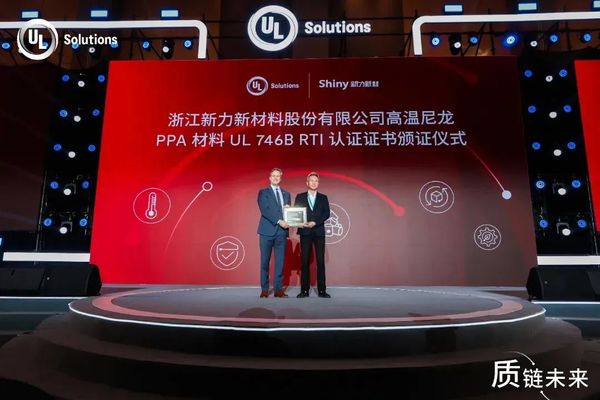The new generation of high-temperature Neodymium ironboron (NdFeB) pyrophosphate (PPA) materials has been successfully passed through the UL (Underwriters Laboratories) certification process in the United States.
The UL certification in the United States is a globally recognized authoritative certification system for product safety and performance, with stringent requirements for various performance indicators of products, especially in the fields of electronics and automotive, regarded as the "gold standard" for market access. (Note: The phrase "金标准" here is kept in its original Chinese form as "gold standard," which is widely recognized internationally in this context.)
Driven by the trend of automotive lightweighting, Sunway New Materials' modified nylon materials have been successfully applied in engine peripheral components and new energy battery brackets, helping customers achieve weight reduction and cost savings. In the electronics field, its high-flow, low-warp special engineering plastics are the ideal choice for manufacturing precision connectors. This breakthrough in PPA materials further strengthens the company's technological leadership in high-temperature application scenarios.

Since its establishment in 2002, Xinnali New Materials has been pioneering in the field of high-performance materials. Currently, the company boasts two production bases for modified plastics and polyamide, with an annual production capacity of over 150,000 tons, demonstrating strong manufacturing strength. In terms of product layout, Xinnali New Materials focuses on the "modified nylon" series as its core, while actively researching and expanding five major series of products, including "modified polycarbonate" and "modified polyester," thereby constructing a diversified product matrix.
From a regional coverage perspective, Xinli New Materials takes Wenzhou as its starting point and gradually expands its business to the southern Zhejiang region as well as the Jiangsu-Zhejiang-Shanghai area. In this economically active and industrially developed region, Xinli New Materials' products, known for their excellent quality, are widely used in the automotive industry, electronics and electrical appliances, transportation, and other fields, making it a trusted material supplier for many enterprises. Whether it is components surrounding automotive engines or precision shells for electronic devices, Xinli New Materials' materials play a crucial role in ensuring product performance and enhancing product quality.
Looking to the future, Sinolink New Materials will continue to focus on the high-performance materials sector, upholding an innovative spirit and constantly exploring cutting-edge technologies to provide customers with higher quality and more efficient material solutions. Against the backdrop of continuously growing global demand for high-performance materials, Sinolink New Materials is expected to leverage the momentum from this UL certification to further enhance its brand reputation and market competitiveness, showcasing the outstanding capabilities of Chinese high-performance material enterprises on the international stage and writing more glorious chapters.
【Copyright and Disclaimer】The above information is collected and organized by PlastMatch. The copyright belongs to the original author. This article is reprinted for the purpose of providing more information, and it does not imply that PlastMatch endorses the views expressed in the article or guarantees its accuracy. If there are any errors in the source attribution or if your legitimate rights have been infringed, please contact us, and we will promptly correct or remove the content. If other media, websites, or individuals use the aforementioned content, they must clearly indicate the original source and origin of the work and assume legal responsibility on their own.
Most Popular
-

List Released! Mexico Announces 50% Tariff On 1,371 China Product Categories
-

Nissan Cuts Production of New Leaf EV in Half Due to Battery Shortage
-

New Breakthrough in Domestic Adiponitrile! Observing the Rise of China's Nylon Industry Chain from Tianchen Qixiang's Production
-

Dow, Wanhua, Huntsman Intensively Raise Prices! Who Controls the Global MDI Prices?
-

Mexico officially imposes tariffs on 1,400 chinese products, with rates up to 50%






